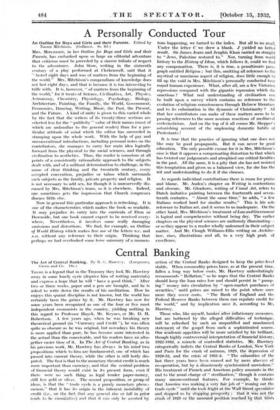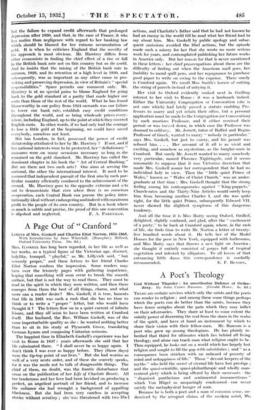Central Banking
TB ERE is a legend that in the Treasury they lock Mr. Hawtrey away in some lonely eyrie (deprive hint of writing materials) and express a hope that lie will " have a good think." After two or three weeks, paper and a pen are brought, and he is asked to write down the results of his meditation. How he enjoys this quaint discipline is not known, but the world has certainly been the gainer by it. Mr. Hawtrey has now for some years . been recognized as one of the four, or five most independent economists in the country, yielding nothing in this regard to Professor Hayek, Mr. Keynes, or Mr. D. H. Robertson.. A few. years ago, when lie was breaking, new theoretical ground (in :" Currency and Credit "), he was often quite as obscure as he was original, but nowadays his theory is more applied than pure, he has become more interested in the actual than the conceivable, and his readers have an alto- gether easier time of it. In The Art of Central Banking, as in his previous work, Mr. Hawtrey his always in his mind two propositions which to him are fundamental, one of which has passed into current theory, while the other is still hotly dis- puted. The first is that to the monetary theorist credit is much more important than currency, and that the central problem of financial theory would exist in its present form, even if there were no such thing as legal tender paper-money, still less gold or silver. The second proposition, or group of ideas, is that:the " trade cycle- is a iurely monetary phenc- inenon," that it has its origin in- the inherent .instability of credit (i.e., on Abe fact that any general rise or fall in 1)04 tends to be—cinnalative) and that it can 'Only lie averted by action of the Central Banks designed to keep the price-level stable. When commodity prices have, as at the present time, fallen a long way below costs, Mr. Hawtrey unhesitatingly recommends " Reflation," so he urges that the Central Banks should keep the loan rates low and should persist in " pump- ing " money into circulation by " open-market purchases, of securities," until prices are raised to the point where once more they cover costs. " The Bank of England and the Federal Reserve Banks between them can regulate credit for the world," and by implication save it, according to Mr. Hawtrey. Those who, like myself, hanker' after inflationary:measures, but are bothered by the alleged difficulties of technique, will be refreshed by such an unqualified and unashamed statement of the gospel from such a sophisticated' source. Our aeademic appetites will be more satisfied by his brilliant, though highly controversial interpretation of financial history, 1922-1932, a miracle of controlled statistics. Mr. Hawtrey categorically indicts the Central Banks of London, isiew, York and paris for the crash of autumn, 1929, the depression of 1929-32, and the crisis. of 1931-2. " The calamities of the last three years have been caused not by mere absence of co-operation, 'bilk by • a disastrously synchronized unwisdom.". His treatment of French and American policy amounts in the end to the usual charge of " sterilization," though it contains Many unconventional features.. For ekaniple, he thinks that America was making a very fair job of " ironing out the trade cycle'"intil she took fright at the Wall Street veeulator and stopPeduSbk-a6Ptiini prosperity s - that" it. *as not the Crash of 190 Or the unsound. position -reached by that but the failure to expand credit afterwards that prolonged depression after 1930, and that, in the case of- France, it sv`As less malice than negligence with regard to her banking law which should be blamed for her ruinous accumulation of gold. It is when he criticizes England that the novelty of his approach is most obvious. Mr. Hawtrey differs from other econoniists in finding the chief effect of a rise or fall in the British bank rate not on this country but on the world. And he insists that the raising of the British bank rate in autumn, 1929, and its retention at a high level in 1930, and subsequently, was as important as any other cause in pro- voking and preserving depression, in view of Britain's " special responsibilities." Space permits one comment only. Mr. liawtrey is at no special pains to blame England for going back to the gold standard at a parity that made higher our costs than those of the rest of the world. What he has found blameworthy in our policy from 1924 onwards was our failure to lower our bank rate, establish easy credit conditions throughout the world, and so bring wholesale prices every- where, including England, up to the point at which they covered English costs. In other words, if we had only had the courage to lose a little gold at the beginning, we could have saved everybody, ourselves not least.
But has London, in fact, possessed the power of credit dictatorship attributed to her by Mr. Hawtrey ? If not, and if her national interests were to be protected, her " deflationary " measures were _on many occasions necessary so long as she remained on the gold standard. Mr. Hawtrey has called the dominant chapter in his book the " Art of Central Banking." But are there not two such arts? One aims at serving the national, the other the international interest. It used to be assumed that independent pursuit of the first aim by each par- ticular country efficiently conduced to the achievement of the second. Mr. Hawtrey goes to the opposite extreme and sits out to demonstrate that even where there is no conscious co-operation, each Central Bank can pursue the policy inter- nationally ideal without endangering and indeed with maximum profit to the people of its own country. But in a book where so much is subtle and precise, the proof of this one convention



























































 Previous page
Previous page